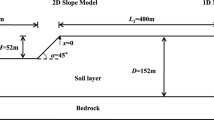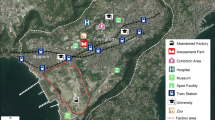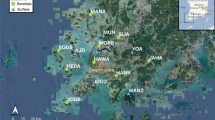Abstract
The spatial variation of ground motion (SVGM) can significantly affect the response of distributed infrastructure systems including bridges, dams, and pipelines. SVGM-related phenomena are the result of the combination of three effects: (1) wave passage, (2) geometric incoherence of the input, and (3) ground- and site-effects due to soil layering, the presence of topographic irregularities, and/or alluvial basins. Existing models are able to capture wave passage and geometric incoherence effects, while ground- or site-effects are either not modeled, or treated in a simplified manner. We perform a numerical experiment by means of the finite element method, exploring the combined effect of wave passage and the presence of 2D topographic features. Such combined effects were observed following recent earthquakes, but were never analyzed using a comprehensive set of numerical analyses. We explore two regularly shaped canyons (semi-circular and V-shaped) and a real case study for a canyon crossed by a multi-span bridge in Italy: the Viadotto Italia. We show that the combined effect of wave passage and topographic features can modify the amplitude and shape of the input motion, altering soil-structure interaction processes involving bridge piers. We also show that path effects, related to the direction of the input motion, have an influence on how input ground motions are modified. For all canyon shapes explored, there is a significant amplification of the vertical component of the motion that sometimes becomes comparable to the horizontal components. We anticipate that outcomes from this research would improve future engineering models and/or site-specific studies.














Similar content being viewed by others
References
Abrahamson NA, Schneider JF, Stepp JC (1991) Empirical spatial coherency functions for applications to soil structure interaction analyses. Earthq Spectra 7:1–27
Ashford AS, Sitar N (1997) Analysis of topographic amplification of inclined shear waves in a steep coastal bluff. Bull Seismol Soc Am 87(3):692–700
Assimaki D, Gazetas G, Kausel E (2005) Effects of local soil conditions on the topographic aggravation of seismic motion: parametric investigation and recorded field evidence from the 1999 Athens earthquake. Bull Seismol Soc Am 95:1059–1089
Assimaki D, Gazetas G (2004) Soil and topography amplification on canyon banks and the 1999 Athens earthquake. J Earthq Eng 8(1):1–43
Assimaki D, Jeong S (2013) Ground-motion observations at Hotel Montana during the M 7.0 2010 Haiti earthquake: topography or soil amplification? Bull Seismol Soc Am 103:2577–2590
Ausilio E, Conte E, Dente G (2008) Seismic response of alluvial valleys to SH waves. In: Seismic engineering conference, AIP conference proceedings, vol 1020, pp 199–206. https://doi.org/10.1063/1.2963835
Ausilio E, Zimmaro P (2012) Topographic effects evaluation for performance-based design. In: Proceedings of 2nd international conference on performance-based design in earthquake geotechnical engineering, Taormina, Italy
Capatti MC, Tropeano G, Morici M, Carbonari S, Dezi F, Leoni G, Silvestri F (2016) Implications of multi-support excitation induced by site conditions, non-linear soil behaviour and SSI on the seismic response of long bridges. Bull Earthq Eng 15(11):4963–4995. https://doi.org/10.1007/s10518-017-0165-z
Celebi, M, Hanks T (1986) Unique site response conditions of two major earthquakes of 1985: Chile and Mexico. In: Proceedings of the international symposium of engineering geology problems in seismic areas, Bari, Italy, vol IV
Cestelli GC, De Miranda F, Pellegrino GC (1965) Il progetto del viadotto sul fiume Lao dell’Autostrada Salerno-Reggio Calabria. Acciaio Costr Metall 6:454–458 ((in italian))
Davis LL, West LR (1973) Observed effects of topography on ground motion. Bull Seismol Soc Am 63:283–298
Durante MG, Brandenberg SJ, Ausilio E, Zimmaro P (2018) Influence of topographic irregularities on the asyncronism of strong ground motions. In: 11th national conference on earthquake engineering, Los Angeles, CA, USA
Elanashai AS, Borzi B, Vlachos S (1999) Deformation-based vulnerability functions for RC bridges. Struct Eng Mech 17(2):215–244
Godinho L, Amado MP, Tadeu A, Cadena-Isaza A, Smerzini C, Sànchez-Sesma FJ, Madec R, Komatitsch D (2009) Numerical simulation of ground rotations along 2D topographical profiles under the incidence of elastic plane waves. Bull Seismol Soc Am 99(2B):1147–1161
Harichandran RS, Vanmarcke EH (1986) Stochastic variation of earthquake ground motion in space and time. J Eng Mech ASCE 112(2):154–174
Kuhlemeyer RL, Lysmer J (1973) Finite element method accuracy for wave propagation problems. J Soil Dyn Div ASCE 99:421–427
Luco JE, Wong HL (1986) Response of a rigid foundation to a spatially random ground motion. Earthq Eng Struct Dyn 14:891–908
Lupoi A, Franchin P, Pinto PE, Monti G (2005) Seismic design of bridges accounting for spatial variability of ground motion. Earthq Eng Struct Dyn 34:327–348
Lysmer J, Kuhlemeyer RL (1969) Finite dynamic model for infinite media. J Eng Mech Div, ASCE, 95(EM4):859–877
McKenna F, Fenves GL (2005) The OpenSees command language manual, version 2.5. Pacific Earthquake Engineering Research Center, University of California, Berkeley. http://opensees.berkeley.edu
Nuti C, Vanzi I (2005) Influence of earthquake spatial variability on differential soil displacements and SDF system response. Earthq Eng Struct Dynam 34:133–1374
Park D, Sagong M, Kwak DY, Jeong CG (2009) Simulation of tunnel response under spatially varying ground motion. Soil Dyn Earthq Eng 29:1417–1424
Sextos AG, Pitilakis D, Kappos AJ (2003) Inelastic dynamic analysis or RC bridges accounting for spatial variability of ground motion, site effects and soil structure interaction phenomena. Part 1: methodology and analytical tools. Part 2: parametric study. Earthq Eng Struct Dyn 32(4):607–652
Sextos AG, Pitilakis D, Kappos A (2005) Evaluation of the new Eurocode 8-part 2 provisions regarding asynchronous excitation of irregular bridges. In: 4th European workshop on the seismic behaviour of irregular and complex structures, Thessaloniki, Paper no. 04
Siro L (1982) Southern Italy November 23 1980 earthquake. In: Proceedings of the 7th European conference on earthquake engineering, Athens, Greece
Trifunac MD (1973) Scattering of plane SH waves by a semi-cilindrical canyon. Earthq Eng Struct Dynam 1:267–281
Vanmarcke EH (1983) Random fields: analysis and synthesis. MIT press, Cambridge, pp 247–264
Wong HL (1982) Effect of surface topography on the diffraction of P, SV and Rayleigh waves. Bull Seismol Soc Am 72:1167–1183
Wu Y, Gao Y, Zhang N, Li D (2016) Simulation of spatially varying ground motions in V-shaped symmetric canyons. J Earthq Eng 20(6):992–1010
Zerva A (1990) Response of multispan beams to spatially incoherent seismic ground motions. Earthq Eng Struct Dyn 19:819–832
Zhang Y, Yang Z, Bielak J, Conte EJP, Elgamal A (2003) Treatment of seismic input and boundary conditions in nonlinear seismic analysis of a bridge ground system. In: 16th ASCE engineering mechanics conference, July 16–18, 2003. University of Washington, Seattle
Author information
Authors and Affiliations
Corresponding author
Additional information
Publisher's Note
Springer Nature remains neutral with regard to jurisdictional claims in published maps and institutional affiliations.
Rights and permissions
About this article
Cite this article
Durante, M.G., Brandenberg, S.J., Ausilio, E. et al. On the combined effect of topographic irregularities and wave passage on the spatial variation of seismic ground motion. Bull Earthquake Eng 20, 3577–3592 (2022). https://doi.org/10.1007/s10518-021-01293-9
Received:
Accepted:
Published:
Issue Date:
DOI: https://doi.org/10.1007/s10518-021-01293-9




